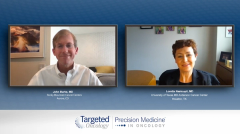
CD19-Targeted mAbs in R/R DLBCL: Tafasitamab
Experts discuss tafasitamab, a CD19-targeted monoclonal antibody (mAb) for treating patients with relapsed/refractory diffuse large B-cell lymphoma (DLBCL).
Episodes in this series

Loretta Nastoupil, MD: Can you walk me through the CD19-targeted monoclonal antibodies? Specifically, what is tafasitamab?
John Burke, MD: Tafasitamab is a humanized anti-CD19 monoclonal antibody. It has a unique design, it’s been engineered. The FC [fragment crystallizable] portion of the antibody has 2 amino acid substitutions that increase the binding affinity of the antibody to the effector cells, like NK [natural killer] cells and macrophages. It seems to recruit those more powerfully than a nonengineered CD19 antibody. It’s administered as an intravenous infusion. Initially, it’s given every week with an extra loading dose during week 1—so weekly for 3 months—then every other week thereafter. It’s then given in combination with lenalidomide and, after 1 year, lenalidomide is discontinued and tafasitamab can then be continued until progression.
The efficacy of this combination of tafasitamab and lenalidomide was shown in the study that’s called L-MIND, and L-MIND was a phase 2 trial that enrolled patients with relapsed DLBCL [diffuse large B-cell lymphoma] who had been treated with between 1 and 3 prior regimens, and the patients were considered not to be candidates for transplant or had relapsed after transplant. One feature of the eligibility is that they did exclude the primary refractory patients from most of the studies. They treated 81 patients on the study and demonstrated an overall response rate of 57% and complete remission rate of 40%. It seems those responses are durable, so they presented longer follow-up at the 2021 ASCO [American Society of Clinical Oncology] annual meeting that showed that the median duration of response was between 3 and 4 years—almost 4 years for the overall patient population.
The median progression-free survival was about 1 year, and the median overall survival was almost 3 years. They also highlighted in their presentation at ASCO, that the results were more favorable in patients who had received only 1 prior therapy as opposed to 2 prior therapies. The big example I would give of that is that the median progression-free survival, when this was used in the second line, was 24 months, so 2 years. Whereas, when it was used in the third line, it was only 8 months. It’s important to recognize that it’s an effective treatment, but it does work better in the second line than the third line. The other take home point that I learned from this is that, when you’re comparing a lot of these different regimens and trials of all these newer agents, it’s important to consider the patient population that they enrolled. That is, a trial that is heavily on third line, the product isn’t going to perform as well as one that has a lot of second-line patients as this.
It does teach you to put the lid on comparing across these trials to compare one new treatment with another just because they have different patient populations. Tafasitamab is relatively well tolerated. We know that the toxicities of the regimen include a fair amount of neutropenia. They did something interesting in this trial, which is that they compared the toxicities in the patients who continued on tafasitamab alone after 1 year with the toxicity rate of the combination during the first year, and you can see a big drop off in the rate of adverse events during that second year of therapy after lenalidomide was stopped. I think it means that you know much of the toxicity that’s seen with this combination does come from lenalidomide.
Transcript edited for clarity.







































